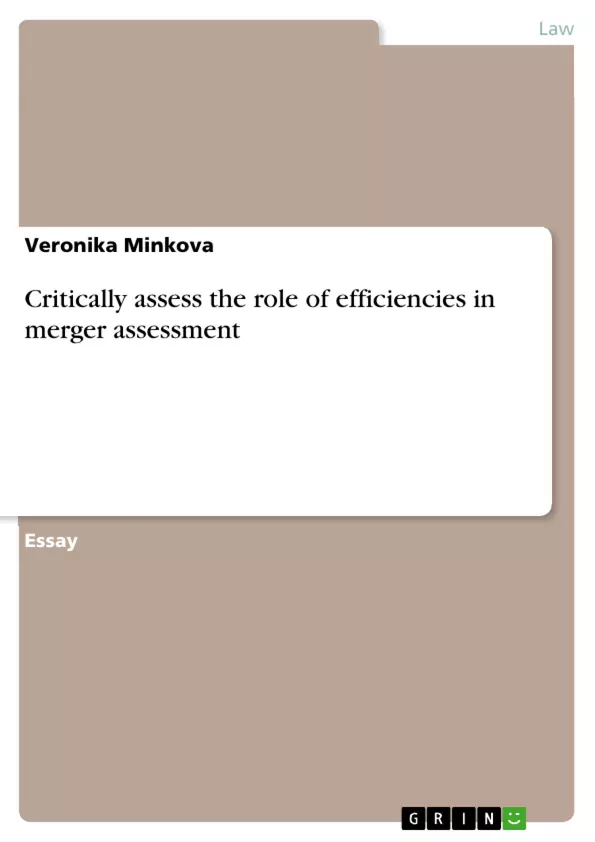The first section of the present essay discusses historically the European Commission’s approach towards efficiencies. The second section elaborates on the choice of welfare standards and explains the European approach of adopting the consumer welfare standard. The third section outlines types of efficiencies according to the economic literature. The fourth section discusses the three cumulative conditions of the European Commission in order to consider efficiency claims. The next section reveals the Commission decisional practice in cases of efficiency claims and analyses its development. In the last chapter more attention is paid to theory and practice of efficiencies in cases of non-horizontal mergers.
Inhaltsverzeichnis (Table of Contents)
- Introduction
- The European Commission's approach towards efficiencies
- Efficiencies not as a defence argument but as a factor in overall appraisal
- Measuring efficiencies against the competitive harm?
- The choice of welfare standard
- Total welfare standard
- Consumer welfare standard
- Typology of efficiencies
- Allocative, Productive and Dynamic Efficiencies
- Five categories of merger-specific efficiencies based on the concept of the production function
- Real cost savings and redistributive (pecuniary) cost savings
- Fixed and variable costs
- Conditions for taking efficiencies into account
- Benefits to consumers
- Merger specificity
- Verifiability
- Commission's decisional practice towards horizontal efficiencies
- Non-horizontal mergers
Zielsetzung und Themenschwerpunkte (Objectives and Key Themes)
This essay examines the role of efficiencies in European merger control. It aims to analyze the historical development of the European Commission's approach to efficiency claims, assess the significance of efficiency arguments in merger appraisal, and explore the application of efficiency considerations in both horizontal and non-horizontal mergers. Key themes include:- The evolution of the European Commission's stance on efficiencies in merger assessments.
- The choice of welfare standard in assessing mergers and the implications for efficiency claims.
- The types of efficiencies recognized within the context of merger control.
- The conditions and criteria the European Commission applies in evaluating efficiency claims.
- The practical application of efficiency considerations in Commission decision-making in horizontal and non-horizontal merger cases.
Zusammenfassung der Kapitel (Chapter Summaries)
The first chapter provides a historical overview of European merger control and introduces the concept of efficiencies as a potential counterbalance to anti-competitive effects. It highlights the evolution of the Commission's approach to efficiencies from an initial skepticism to a more open stance in recent years.
The second chapter delves into the Commission's framework for evaluating efficiencies, emphasizing that they are not seen as a standalone "defense" but rather as a factor considered in the overall appraisal of a merger. The chapter also discusses the challenges of measuring efficiencies against potential competitive harm, and the lack of clear guidance on this aspect.
The third chapter focuses on the choice of welfare standard in merger assessments, contrasting the total welfare standard with the consumer welfare standard. It explains why most jurisdictions, including the European Union, primarily rely on the consumer welfare standard.
The fourth chapter outlines a typology of efficiencies, including allocative, productive, and dynamic efficiencies. It further explores various categories of merger-specific efficiencies based on the concept of the production function, highlighting the distinction between real cost savings and redistributive cost savings.
The fifth chapter examines the three key conditions the European Commission utilizes to consider efficiency claims: benefits to consumers, merger specificity, and verifiability. This chapter explores the significance of each condition and its application in practical decision-making.
The sixth chapter examines the Commission's decisional practice towards horizontal efficiencies. It provides insights into the Commission's approach to handling efficiency claims in cases involving horizontal mergers and explores the evolution of this practice over time.
The seventh chapter delves into the theory and practice of efficiencies in cases of non-horizontal mergers. It analyzes the application of efficiency considerations in mergers that do not solely involve competitors within the same market.
Schlüsselwörter (Keywords)
The core concepts addressed in this essay include European merger control, efficiency claims, competitive appraisal, welfare standards (consumer welfare and total surplus), typology of efficiencies (allocative, productive, dynamic), merger specificity, verifiability, horizontal mergers, non-horizontal mergers, and the European Commission's decisional practice.- Quote paper
- Veronika Minkova (Author), 2011, Critically assess the role of efficiencies in merger assessment, Munich, GRIN Verlag, https://www.grin.com/document/179302



